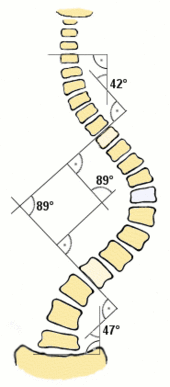Cobb angle
The Cobb angle (also known as Cobb angle , after John Robert Cobb ) was originally used to classify scoliosis in order to measure the deviations of the spine in the frontal plane using an X-ray image .
Therapeutic meaning
Lateral bends of the spine from 10 degrees in children are called scoliosis, but they should only be treated orthopedically from 20 degrees. This affects around 0.4% of children undergoing preventive medical checkups, mostly girls. Otherwise, the bending can be expected to progress. In addition to physiotherapy , if the Cobb angle is greater than 25 degrees, orthosis fitting is used. Surgical intervention makes sense from around 50 degrees, in special cases even earlier.
determination
The general determination of the Cobb angle is done by first determining the neutral vortices . A neutral vortex is a vortex at the turning point of the side deflection. Since there is a turning point of the lateral bending both above (cranial) and below (caudal), there is also an upper and a lower neutral vertebra. Now you put a tangent on the top plate of the upper neutral vertebra and another on the bottom plate of the lower neutral vertebra. The Cobb angle is the angle at which the tangents intersect. Another method uses two straight lines instead of tangents, each perpendicular to the top plate of the upper and the bottom plate of the lower neutral vortex. The cutting angle is also in here the Cobb angle.
In the meantime, the method has been adapted to classify deviations in the sagittal plane to anterior-posterior (front-back), especially in the case of traumatic fractures of the thoracic and lumbar spine . In connection with spinal injuries and the assessment of deviations in the sagittal plane, the angle is measured as follows: The perpendicular is made on the extension of the upper edge of the vertebra above the fracture and on the extension of the lower edge of the vertebra below the fracture . The angle is measured at the intersection of these two straight lines.
The Cobb angle is the preferred method of measuring post-traumatic kyphosis , as found in a recent meta-analysis of classifications of traumatic vertebral body fractures.
Individual evidence
- ↑ Fewer operations thanks to rods that grow with the patient . Springer-Verlag GmbH. 2012. Archived from the original on November 14, 2017. Info: The archive link has been inserted automatically and has not yet been checked. Please check the original and archive link according to the instructions and then remove this notice.
- ^ JR Cobb: The American Academy of orthopedic surgeons instructional course lectures . Vol. 5. Edwards, Ann Arbor, MI 1948 (English).
- ^ Victor C. Strasburger: Adolescent Medicine: A Handbook for Primary Care . Lippincott Williams & Wilkins, 2006, ISBN 978-0-7817-5315-9 , pp. 85-87 (accessed August 17, 2013).
- ^ Klaus Buckup: Pediatric Orthopedics . Georg Thieme Verlag, 2001, ISBN 978-3-13-697602-9 , p. 69 (accessed on August 17, 2013).
- ^ Fritz Uwe Niethard, Joachim Pfeil, Peter Biberthaler: Dual series of orthopedics and trauma surgery. 5th edition. Georg Thieme, Stuttgart 2005, ISBN 3-13-130815-X , p. 348.
- ↑ Determination of the Cobb angle in scoliosis. apotheken-umschau, accessed on June 5, 2011.
- ↑ Ory Keynan include: Radiographic Measurement parameter in Thoracolumbar Fractures: A Systematic Review and Consensus Statement of the Spine Trauma Study Group: . In: Spine . tape 31 , no. 5 , March 2006, p. E156 – E165 , doi : 10.1097 / 01.brs.0000201261.94907.0d (English).
